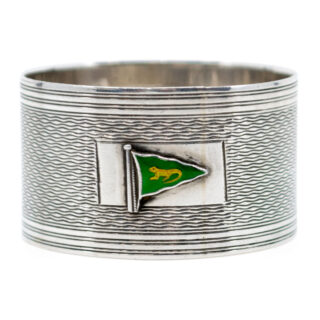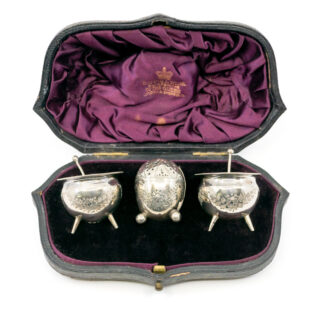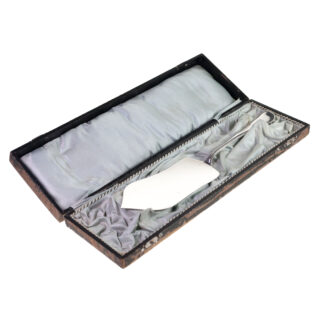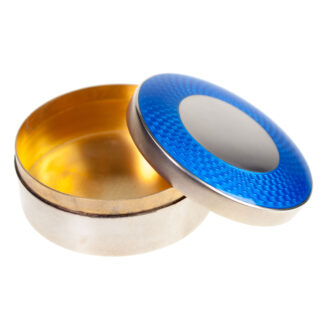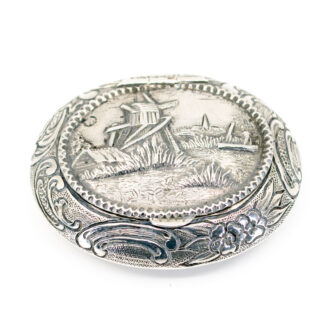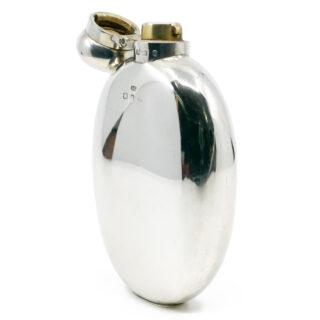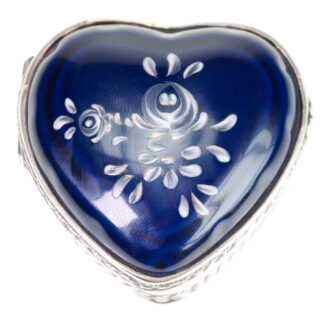This gorgeous cup is decorated with champlevé enamel and is crafted in silver. It was made by D. Anderson in Norway around 1925. Champlevé is a decorative technique in which small cells or compartments are carved into a metal surface and then filled with enamel or other materials to create a colorful design.
Details: Enamel, Silver Cup *.
Dimensions: H 6.5 x W 6 cm .
Weight in grams: 87.
Condition: Very good condition – slightly used with small signs of wear.
Shipping and Pickup: This gorgeous piece ships from our store located in the center of Amsterdam, The Netherlands. We offer both registered shipping and local pickup at our store. In the case of local pickup, any applicable shipping costs will be refunded.
About Us: Add some sparkle to your style with Binenbaum.com. We offer a stunning selection of antique and vintage jewelry that you won’t find anywhere else. From timeless rings and dazzling necklaces to unique brooches, we have something for every taste and occasion. Visit our website today and treat yourself to a piece of history.
| Design Era | |
|---|---|
| Design & Historical Context | Art Deco jewelry, also known as Jazz Age jewelry, became popular in the 1920s and remained in style through the 1930s. It was named after the Exposition International des Arts Décoratifs et Industriels Modernes, a exhibition held in Paris in 1925 that was largely dedicated to the jewelry arts. This style was inspired by a variety of cultural and artistic movements, such as Oriental, African, and South American art, as well as Cubism and Fauvism. Art Deco jewelry is known for its sharp, straight lines and emphasis on modernity and the machine age. During the Art Deco era, there were significant improvements in diamond cutting techniques, which made diamonds more radiant and sparkling than ever before. This, along with increased prosperity, allowed more people to afford diamond jewelry and engagement rings. Additionally, new casting techniques made it possible to produce more intricate and detailed settings. Art Deco jewelry was not only fashionable but also reflected the social and cultural changes of the time. The bold, modern design of Art Deco jewelry reflected the liberation and empowerment of women during the 1920s and 1930s. Today, Art Deco jewelry is highly sought after by collectors and is often featured in museum exhibitions and high-end auctions. |
| Key Materials | |
| Materials & Craftsmanship | Silver Silver is a white metallic element that is known for its excellent conductivity of heat and electricity. It is represented on the periodic table of elements by the symbol Ag, and it is a member of the noble metals, which are known for their excellent resistance to oxidation. Silver is a relatively soft metal, with a hardness that is intermediate between gold and copper. It is more malleable and ductile than gold, which means that it can be easily shaped and molded into various forms. However, it is not as hard as copper, which means that it is more prone to scratches and other types of damage. Because of its softness, silver is usually alloyed with another metal to harden it enough to maintain the desired shape and details when it is used in jewelry and other decorative objects. This helps to give it the necessary strength and durability for use in these types of applications. Throughout history, silver has played a prominent role in the production of jewelry and objets d'art. It is prized for its beauty and versatility, and it is often used in a wide variety of different types of jewelry, including rings, earrings, pendants, and bracelets. It is also used in decorative objects, such as candlesticks, vases, and other decorative items. Enamel Enameling is a decoration technique in which a glass of certain composition is fused to the surrounding or under laying metal. Although the exact origins are unknown, the art of enamelling has been practiced since ancient times. The favor of adorning jewelry with bright colors has always existed and the use of glass created colors which nature – in the form of gemstones – could not provide for in ancient times. Excavations on Cyprus – in the Mediterranean – in the 1950's brought cloisonné enameled jewelry to the surface which dates from the 13th and 11th century BC. These are, to date, the earliest enameled items found in this particular technique. |
| Dimensions | H 6.5 x W 6 cm |
| Gender | |
| Weight (in grams) | 87 |
| Condition | Very good condition – slightly used with small signs of wear |
Enhance the Beauty of Your Jewelry with Proper Care
Wearing your jewelry is a special way to express yourself and add a touch of personal style to any look. However, to ensure your jewelry remains in pristine condition, there are a few simple steps you need to take to keep it looking its best.
General Care Instructions:
Remove jewelry when showering or bathing, especially when at the beach, in the sea or in chlorinated water.
Avoid wearing jewelry while doing physical work such as housekeeping, gardening or exercise.
Storing your jewelry in a dry and cool place will help protect it from moisture, dirt and dust.
Keeping it away from harsh chemicals such as bleach, ammonia and chlorine will help to avoid discoloration and damage.
Cleaning your jewelry regularly with a soft cloth will help to keep it looking shiny and new.
Avoid exposing your jewelry to extreme temperatures, such as leaving it in direct sunlight or near a heater, as this can cause damage.
Handle your jewelry carefully and avoid dropping it, as this can cause the stones to loosen or the metals to scratch.
Finally, if possible, have your jewelry professionally checked and serviced. This will ensure that any potential problems are spotted and fixed before they become worse.
By following these tips, you can enjoy your precious jewelry for many years to come.
Related products
-
Enamel Silver Engine Turned Napkin Ring 8181-2569
€ 185,00 VAT incl. (where applicable) -
Silver Antique Salt Cellar 10821-2758
€ 995,00 VAT incl. (where applicable) -
Silver “Cake And Pie Server” Cutlery 7838-2495
€ 595,00 VAT incl. (where applicable) -
Silver Horse And Carriage Miniature 1301-1686
€ 245,00 VAT incl. (where applicable) -
Enamel Silver Silver-Gilt Guilloche Box 1427-1904
€ 795,00 VAT incl. (where applicable) -
Silver Oval-Shape Box 10583-2750
€ 395,00 VAT incl. (where applicable) -
Silver Antique Hip Flask 8990-2646
€ 995,00 VAT incl. (where applicable) -
Enamel Porcelain Silver Heart-Shape Box 827-0841
€ 595,00 VAT incl. (where applicable)
- Home
- Collection
- Fine Jewelry
- Silver Jewelry
- Silverware
- Boxes
- Candlesticks
- Salt and pepper shakers
- Miniatures
- Salt cellars
- Spoon Set
- Condiments
- Frames
- Napkin Ring
- Spoon
- Oddities
- Cups
- Vases
- Cutlery
- Serving Spoon And Cake Server
- Candlesticks
- Baskets
- Hanukkiah
- Spice Tower
- Yad
- Tea Set
- Sugar Castor
- Napkin Rings
- Wine Bottle Coaster
- Wine Stopper
- Tea Pot
- Jugs
- Rattles
- Hip Flask
- Miscellaneous
- Rings 💍
- About
- Contact

